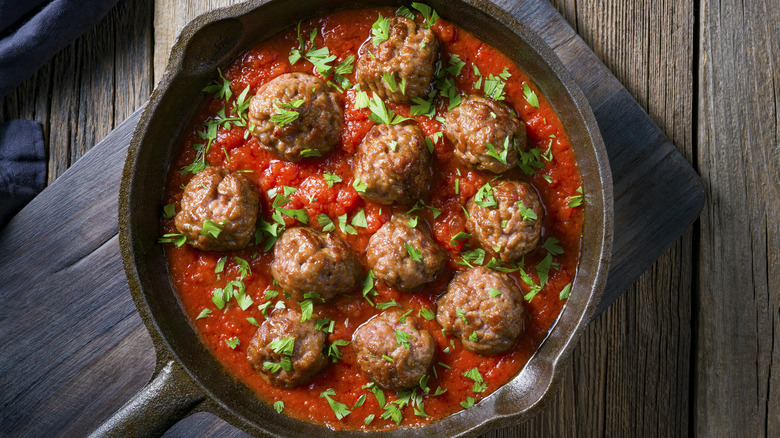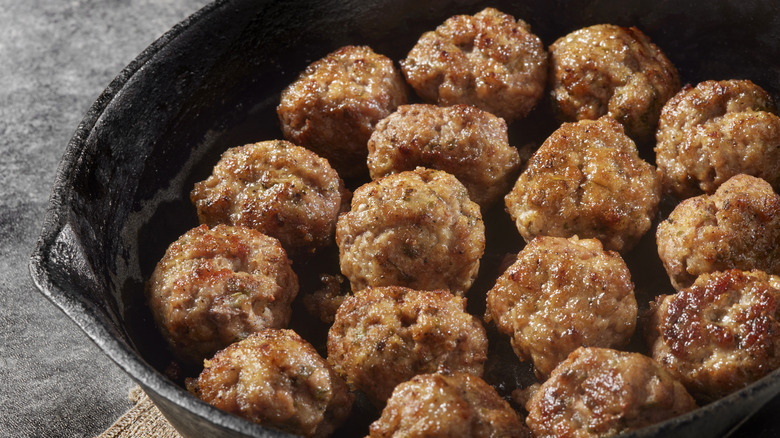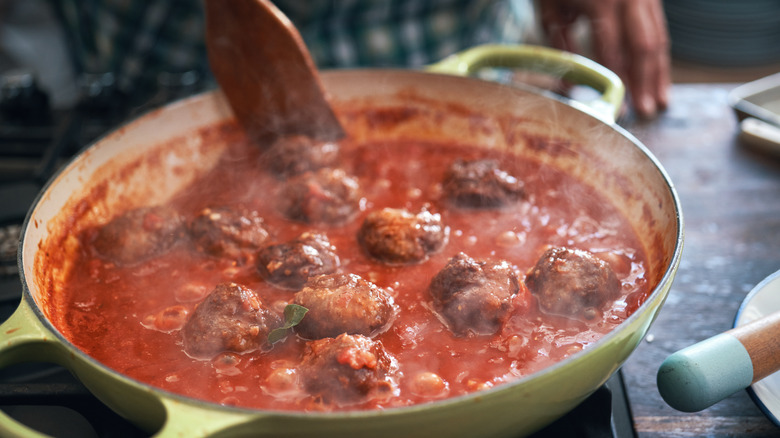The Simple Pantry Swap For Breadcrumbs In Meatballs
Meatballs are the perfect blend of "comfort food" and "fun food," making them one of those special dishes that both a toddler and a gourmet can appreciate in equal measure (if not for the same reasons). Besides being hearty and tasty, they're also delightfully round — a quality they retain throughout the cooking and serving process if made with the right binding agents. The best meatball recipes typically feature a binder of breadcrumbs, but what if you're out of this crucial ingredient, or you've just learned one of your guests can't eat gluten? With no time for a run to the store, do you scrap your meatball idea and scramble to pull together an alternative main? Luckily, there's a simple solution that won't require a hasty menu rearrangement, and it involves a food that's probably sitting in your pantry right now.
Oats are one of the best binders for meatballs by far. This simple swap can save the day whether you're avoiding bread or are just in the mood to experiment with something different. The grains work so seamlessly as a breadcrumb replacement that oat-packed meatballs might just become your new go-to.
Why use oats instead of breadcrumbs in meatballs?
You probably associate oats with morning porridge or chunky oatmeal raisin cookies, but there are plenty of good reasons to expand your view of this versatile ingredient and put it to work in your meatballs. Oats achieve the same result as breadcrumbs, acting as a binder and contributing to the structural integrity of the meatballs, soaking up the juices as the meat cooks, and helping to keep all that flavor locked in. On top of that, they have fewer calories than breadcrumbs, as well as more fiber. They also provide complex carbohydrates, which digest at a more gradual rate than the simple carbs that breadcrumbs provide, and thus are better for avoiding blood sugar spikes.
If you're concerned that your meatballs will taste like oats, we have good news. If incorporated the right way into your mixture, (i.e. follow the recipe and keep to the right ratios) there's no discernible difference in flavor between meatballs made with oats and those that use breadcrumbs, especially not if you stew them in a rich, flavorful tomato or cream sauce. What you may notice, however, is that the end result is juicier than a traditional meatball. That's because oats absorb more liquid than breadcrumbs, another point in their favor.
How to use oats in your meatball mixture
Almost any style of oatmeal will work when subbing in oats for your meatball mixture: Old-fashioned, quick-cooking, or rolled all work fine, with a few caveats. If you're working with rolled oats, the large grains will be obvious in the meatballs if you don't run them through a food processor or coffee grinder beforehand, but this step is really just for looks. If you're going with steel-cut, it would be a good idea to get the quick-cooking variety. Regular steel-cut oats may not become hydrated enough when you soak them to make the panade; they also take longer to cook. Both these factors could result in meatballs with a gritty texture.
To make the meatballs, soak your oats in a mixture of egg and milk for about five minutes (or an hour if you're using old-fashioned oats). Stir in the other ingredients, mix in your meat, and let it rest for about 15 minutes. After that, bake or pan-fry your meatballs as you typically would if using breadcrumbs. In terms of ratios, some cooks prefer to use the same quantity of dry oats as they would breadcrumbs: about ¼ cup per pound of meat. Others might opt for ½ cup of oats per pound of meat. You can always start with the lower amount and gauge how much liquid the oats will absorb while they're soaking, adding more if needed.
Considering how easy it is to swap in oats for breadcrumbs, plus the fact that they yield juicier, more nutritious, equally delectable results, it's time to give this pantry staple substitute a try. And who knows? Maybe Ikea will pick up on this tip and create a gluten-free version of its famously cheap meatballs.


